Related Research Articles

David Crockett was an American folk hero, frontiersman, soldier, and politician. He is often referred to in popular culture as the "King of the Wild Frontier". He represented Tennessee in the U.S. House of Representatives and served in the Texas Revolution.

The Alamo is a historic Spanish mission and fortress compound founded in the 18th century by Roman Catholic missionaries in what is now San Antonio, Texas, United States. It was the site of the Battle of the Alamo in 1836, a pivotal event of the Texas Revolution in which American folk heroes James Bowie and Davy Crockett were killed. Today it is a museum in the Alamo Plaza Historic District and a part of the San Antonio Missions World Heritage Site.
William Barret "Buck" Travis was a 19th-century American lawyer and soldier. He is known for helping set the Texas Revolution in motion during the Anahuac disturbances and commanding the Misión San Antonio de Valero as a lieutenant colonel in the Texian Army.

James Bowie was a 19th-century American pioneer, slave smuggler and trader, and soldier who played a prominent role in the Texas Revolution. He was among the Americans who died at the Battle of the Alamo. Stories of him as a fighter and frontiersman, both real and fictitious, have made him a legendary figure in Texas history and a folk hero of American culture.

David Gouverneur Burnet was an early politician within the Republic of Texas, serving as the interim president of Texas in 1836, the second vice president of the Republic of Texas (1839–1841), and the secretary of State (1846) for the new state of Texas after it was annexed to the United States.
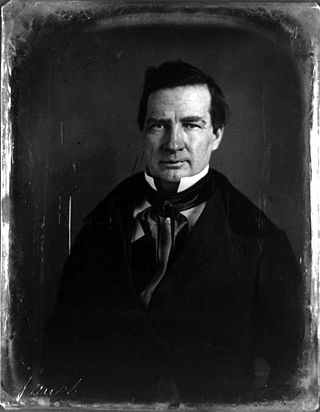
Thomas Jefferson Rusk was an early political and military leader of the Republic of Texas, serving as its first Secretary of War as well as a general at the Battle of San Jacinto. He was later a US politician and served as a Senator from Texas from 1846 until his suicide. He served as the President pro tempore of the United States Senate in 1857.
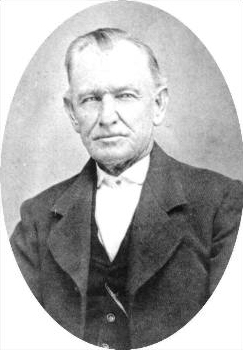
Henry Eustace McCulloch was a soldier in the Texas Revolution, a Texas Ranger, and a brigadier general in the army of the Confederate States during the American Civil War.
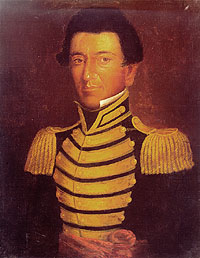
Juan Nepomuceno Seguín was a Spanish-Tejano political and military figure of the Texas Revolution who helped to establish the independence of Texas. Numerous places and institutions are named in his honor, including the county seat of Seguin in Guadalupe County, the Juan N. Seguin Memorial Interchange in Houston, Juan Seguin Monument in Seguin, World War II Liberty Ship SS Juan N. Seguin, Seguin High School in Arlington.
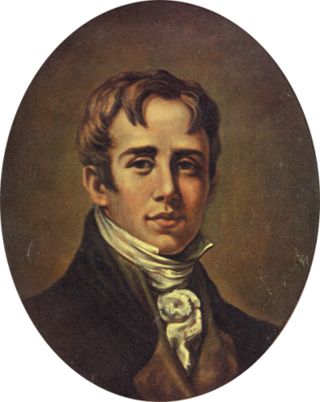
James Butler Bonham was a 19th-century American soldier who died at the Battle of the Alamo during the Texas Revolution. He was a second cousin of William B. Travis and was a messenger of the Battle of the Alamo. His younger brother, Milledge Luke Bonham, was a brigadier general in the Confederate States Army in the American Civil War, and served as Governor of South Carolina from 1862 to 1864.
James Clinton Neill was an American soldier and politician, most noted for his role in the Texas Revolution and the early defense of the Alamo. He was born in North Carolina and served in the Alabama House of Representatives between 1825 and 1827.
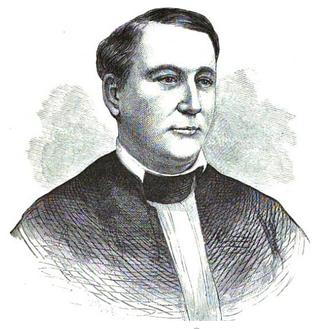
Thomas William Ward was an Irish-born American soldier and politician who served three nonconsecutive terms as the mayor of Austin, Texas. Ward also served as the 3rd Commissioner of the Texas General Land Office and United States consul to Panama.

Harold Pierce Cazneaux, commonly referred to as H. P. Cazneaux, was an Australian photographer; a pioneer whose style had an indelible impact on Australian photographic history. In 1916, he was a founding member of the pictorialist Sydney Camera Circle. As a regular participator in national and international exhibitions, Cazneaux was unfaltering in his desire to contribute to the discussion about the photography of his times. His career between the Wars established him as "the country's leading pictorial photographer".

Moses Yale Beach was an American inventor, entrepreneur, philanthropist and publisher, who founded the Associated Press, and is credited with originating print syndication. His fortune, as of 1846, amounted to $300,000, which was about 1/4 of the fortune of Cornelius Vanderbilt at the time, and was featured in a book that he published named the Wealthy citizens of the City of New York.
William Telemachus McManus was an American lawyer and politician from New York.
Jane Maria Eliza Cazneau was an Irish-American journalist, lobbyist, and publicist who advocated the annexation of all of Mexico during the Mexican–American War.
Francisco Antonio Ruiz was the alcalde of San Antonio during the Texas Revolution and was responsible for identifying the bodies of those killed at the Battle of the Alamo.
John William Smith was a Republic of Texas and American political figure, the first mayor of San Antonio under the Republic, and the first mayor of San Antonio under the state of Texas. He supported and served Texas during the struggle for Texas Independence.

Matthew Caldwell,, also spelled Mathew Caldwell was a 19th-century Texas settler, military figure, Captain of the Gonzales – Seguin Rangers and a signer of the Texas Declaration of Independence. Because of his recruitment ride ahead of the Battle of Gonzales, some call him the Paul Revere of Texas.
Andrew Jackson Sowell was a lifelong soldier and farmer in the 19th century. He was a participant in the Texas Revolution and a survivor of the siege of the Alamo. He continued his service during the years of the Republic of Texas, in the Mexican–American War, and the Civil War. He was a frontier defender, early Texas Ranger, and a friend and scout with Kit Carson.

Eleazer Lee Waterman was a Vermont attorney, politician and judge. He was most notable for his service as a judge of the Vermont Superior Court (1906-1919) and as the court's chief judge (1917-1919).
References
- William Leslie Cazneau from the Handbook of Texas Online